Contents (go to): Introduction ¦ Background ¦ Survey ¦ Workshop ¦ Theories ¦ Project ¦ Green campus ¦ Reflections
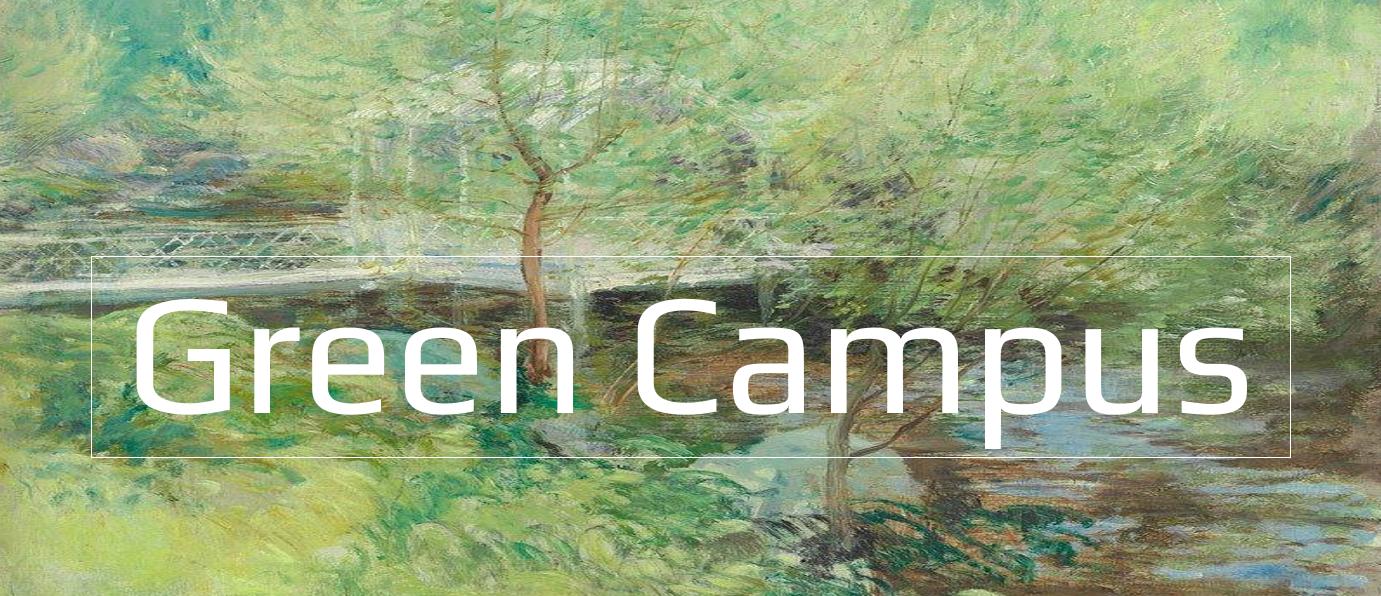
Introduction
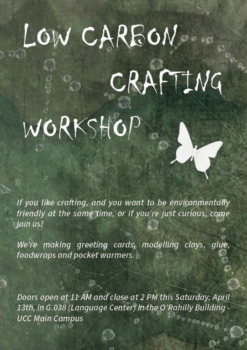 This website documents a student project which was carried out in 2021 as part of our course work for a University Wide Module UW0012 Global Citizenship and Development Education, run by the Praxis Project and the School of Education, UCC. Course lecturer was Dr Gertrude Cotter.
This website documents a student project which was carried out in 2021 as part of our course work for a University Wide Module UW0012 Global Citizenship and Development Education, run by the Praxis Project and the School of Education, UCC. Course lecturer was Dr Gertrude Cotter.
As a group we all researched different topics in the context of global warming and climate change. The current environmental situation forces us to think twice when we make decisions, and in some cases it can be very difficult to make the right choice to meet the needs. Potential to lower our carbon footprint is in all aspects of life – at work, at home, in our spare time.
Following Gertrude’s suggestions for different action plans, we focused on creating a survey and organising a low impact workshop. The possibilities to create environmentally items seem endless, whether it’s upcycling unwanted items and materials, making own cleaning equipment or personal hygiene products. Eventually we decided to focus on crafting with all its benefits explained later, because we thought that hard working students could need an activity that distracts them from their busy college life every now and then. In our workshop, we want to show eco friendly alternatives to make art. Keeping with the motto “What’s good for the environment, is good for people”, we want to introduce materials and methods that are natural and non toxic.
Schedule for 2024
- Survey
- Ongoing until the end of April.
- Workshop
- Saturday, 13th April, ORB G38.
- Presentation
- Tuesday, 16th April.
Why Crafting?
Crafting offers many benefits beyond just being a fun activity. Engaging in crafting activities can promote stress relief and cognitive stimulation and provides opportunities for social interaction. Here are several reasons why crafting is not only good for children but for people of all ages.
Stress Relief: Crafting offers a therapeutic outlet for releasing stress. Engaging in creative activities like painting, knitting, or sculpting can help individuals unwind and relax. The focus required during crafting can divert attention away from worries and concerns, creating a sense of calmness and wellbeing.
Promotion Of Mindfulness: A number of crafting activities forces people to be in the present moment and focus on the task they are doing. Whether it’s knitting, woodworking, or pottery, the rhythmic motions and repetitive actions of crafting can create a state of mindfulness similar to meditation. Utilizing crafting as a mindfulness practice, it can reduce anxiety, improve mood, and enhance overall wellbeing.
Creativity Boost: Crafting encourages people to explore their creative side and think outside the box. Whether it’s designing a unique piece of art or experimenting with different colours in a painting, crafting fosters innovation and originality. Regularly engaging in creative activities can help enhance problem-solving skills and inspire new ideas in other areas of life.
Sense of Accomplishment: Completing a craft project provides a sense of success and fulfilment. Whether it’s a simple DIY project or a complex masterpiece, seeing the results of one’s efforts can boost self-esteem and confidence. This feeling of accomplishment can be a motivation to set and achieve more goals in other aspects of their lives.
Social Connection: Crafting can provide opportunities for people to connect with others who share the same interests. Joining crafting clubs, attending workshops, or participating in online communities allows individuals to bond over their passion for creativity. These social interactions create a feeling of belonging and can help people who feel lonely and isolated.
Improvement Of Cognitive Function: Cognitive functions like memory, concentration, and problem-solving are stimulated when people are occupied with crafting activities. Following instructions, making decisions about materials and colours, and executing crafting techniques keep the brain active and engaged. This can help not only the overall cognitive function but also, according to research, reduce or even prevent memory loss and dementia.
Emotional Expression: Through crafting people can express emotions and feelings in a non-verbal way. People can show their inner thoughts, experiences and struggles visually compelling through arts and crafts. Especially to those who have difficulties articulating their feelings, crafting can have a therapeutic effect.
Environmental Benefits: Crafting often includes repurposing and/or upcycling materials and items, which promotes sustainability and reduces waste. By transforming old or unused items into something new, environmental conservation efforts are supported and a more eco-friendly lifestyle is promoted.
In conclusion, crafting is a valuable and enriching activity for people of all ages because it offers a vast amount of benefits beyond mere entertainment. Whether people craft to relax, to be creative, to socialise or to stimulate their brain, crafting does have the power to enrich their lives and enhance their overall wellbeing.
Background Research
The Green Campus initiative was introduced to UCC in 2007.
Many primary and secondary schools throughout Ireland are part of An Taisce’s Green Schools Initiative, and UCC followed a similar plan for beginning their journey towards a Green Campus.
In 2010, UCC was first university in the world to be awarded a Green Flag from the Foundation for Environmental Education. UCC has implemented a Sustainability and Climate Action Plan (2023-2028) with the target of becoming a Zero Waste certified campus by 2030.
Students are aware of designated recycling facilities on the campus (including on the ground floor of the Boole Library).
Survey
Survey Preparation
Our carbon footprint is the total of greenhouse gases we have generated throughout our lives and our actions. Everyday we partake in action, both big and small, that contribute to the worsening of the world’s’ global warming.
Our Carbon footprint contributes to a major percentage of the global climate change that the Earth is experiencing. Every individual, organisation, company, and community have a hand in the gases that effect our atmosphere. A carbon footprint is the calculated measurement of these gases compared with the responsible group or individual’s effect on the atmosphere. Throughout this project, we wondered on how much the public thought about their impact on the world through their carbon footprint.
This survey investigated the level of knowledge the general student has on this issue and how they would like to learn more about how they can lessen their impact on the environment. It investigated the general awareness students have toward their carbon footprint and on the steps that have been taken in their lives to educate and encourage them to partake in more sustainable choices of everyday life.
There are many sustainable suggestions offered to households and businesses to decrease their contribution to the world’s rising greenhouse gases, through the efforts of government initiatives and incentives. While these efforts are very important to the challenge of reducing the country’s greenhouse gas emission, it does exclude individuals who are not as heavily involved in such extensive efforts. Many citizens who put efforts into reducing their carbon footprint are more likely to commit to smaller, daily activities they can partake in. This was the inspiration for our ‘low carbon crafting’ workshop. Our group wanted to introduce sustainable everyday activities into people’s lives, allowing them to benefit from their learning while also helping them reduce their dependence on less sustainable alternatives. This workshop had a variety of options available for the participants to learn to improve their carbon footprint.
Sample of the survey
https://forms.gle/gCp9FzHy2sHxKoF6A

Our Carbon footprint contributes to a major percentage of the global climate change that the Earth is experiencing. This survey investigated the level of knowledge the general student has on this issue and how they would like to learn more about how they can lessen their impact on the environment.
Survey Evaluation Results
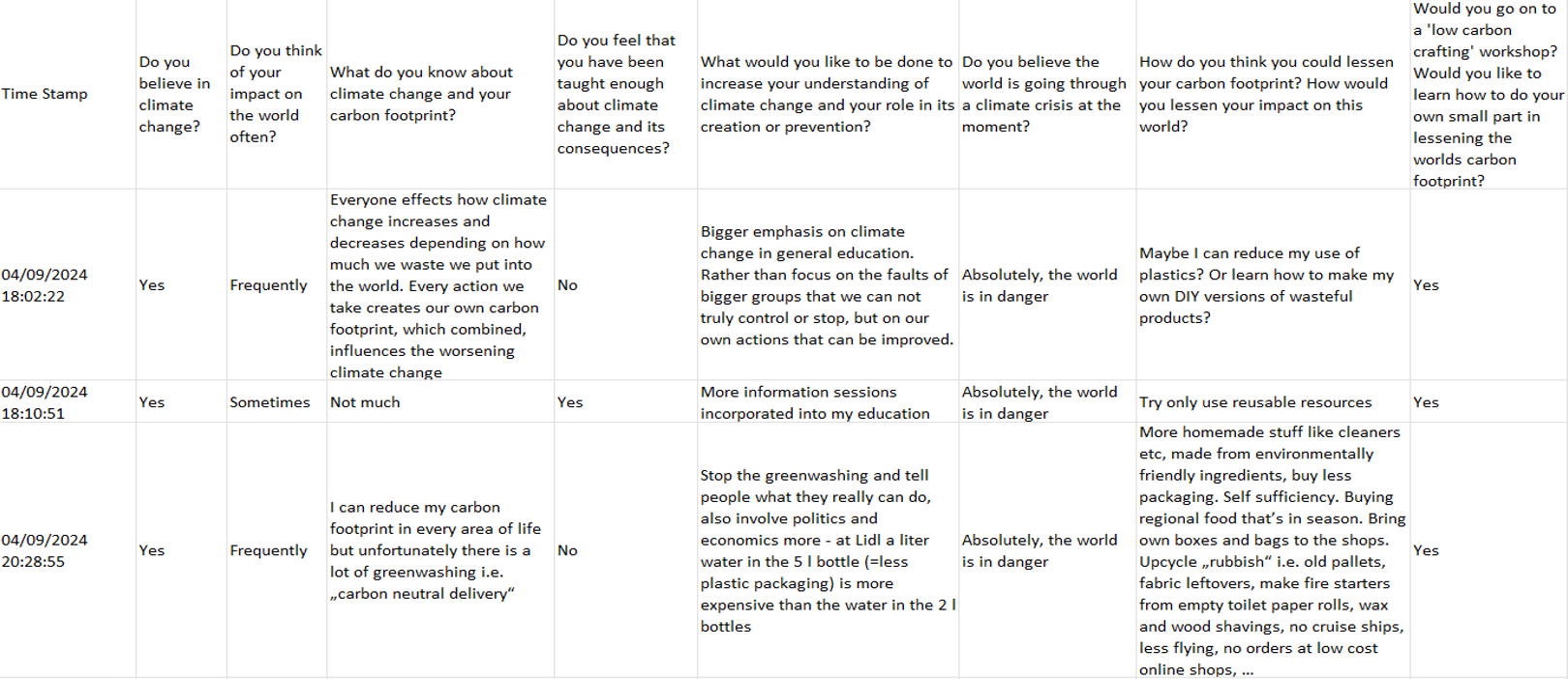

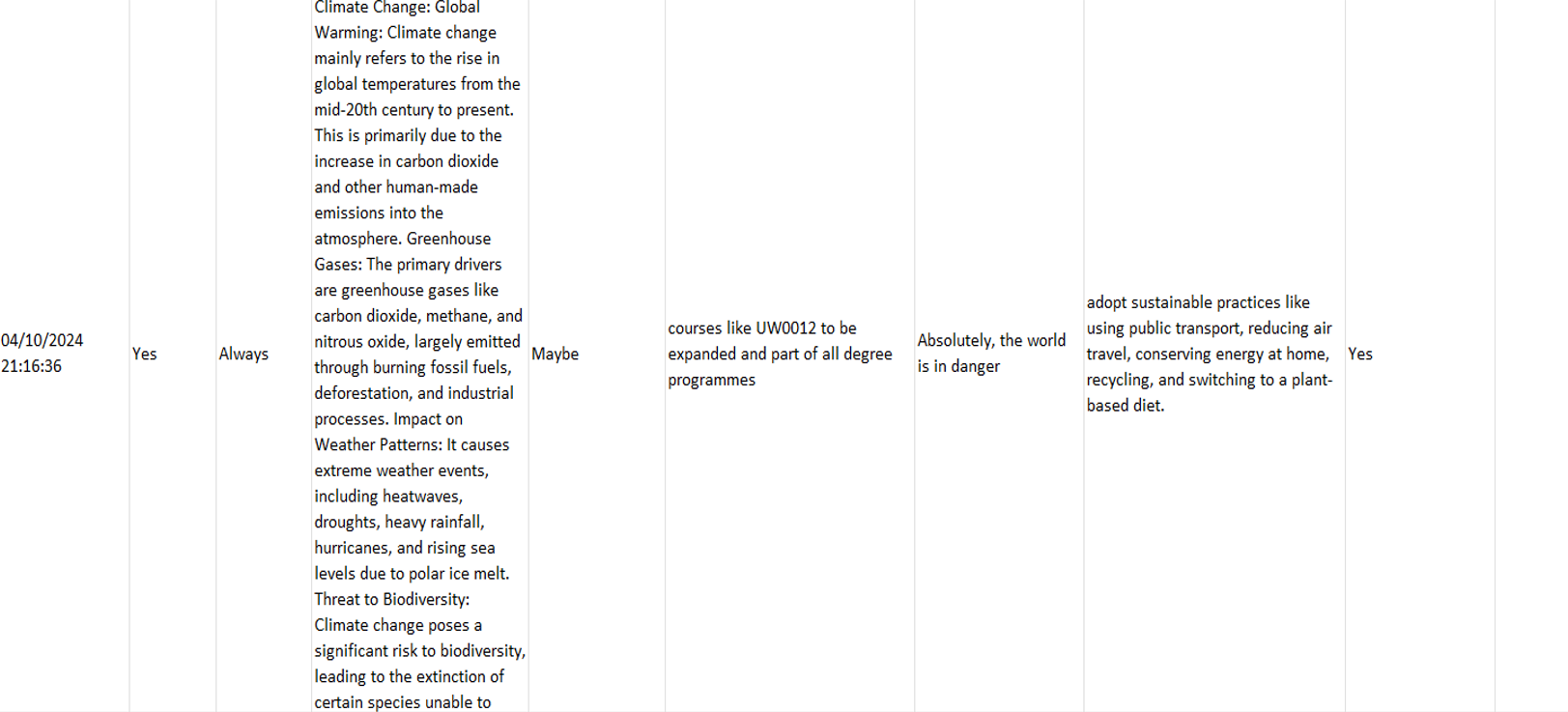
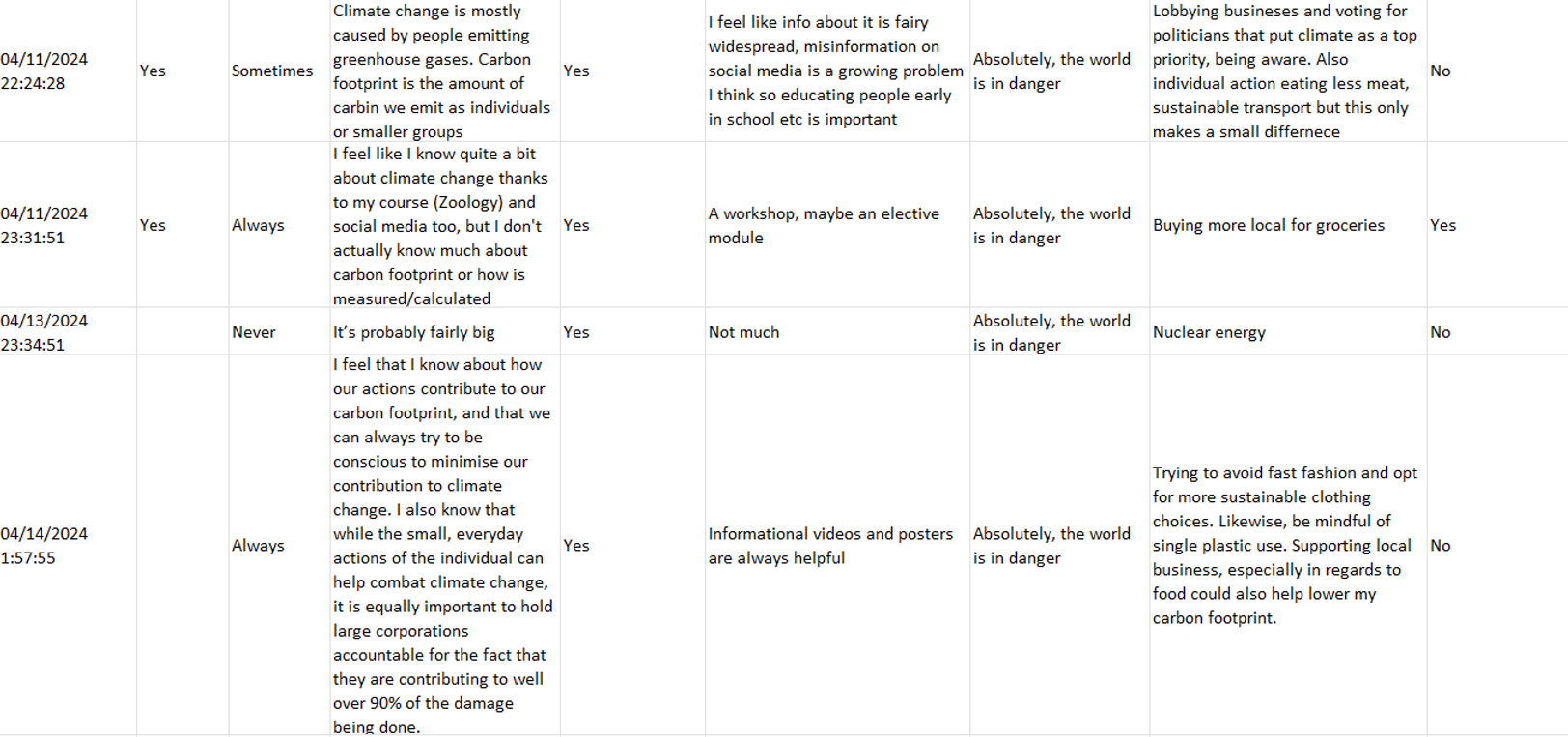


Workshop
Workshop Preparation
To organise the workshop, a few things had to be considered:
- Date and time.
- Location.
- Advertisement.
- Contents.
- Feedback.
Gertrude kindly supported us by booking a room for us and helping to get the materials needed for the workshop, as well as announcing the workshop.
For the advertisement, a poster was created. Pinning up the poster was not condoned though due to UCC’s no print policy and we were encouraged to circulate advertisements online. By the nature of the topic, we also made a last-minute crafted and entirely compostable advertisement that was pinned up in the Student Centre. However, it has to be critically mentioned, that the digital world has its fair share in the climate crisis issues – there is nearly no recycling in this domain and according to studies the resources for maintaining a digital world will become scarce in 30 to 50 years (Arte, 2022).
The items we were planning to make included different modelling clays, a glue, greeting cards, pocket warmers and beeswax foodwraps. Some of the items were already familiar, others had to be tested – which was great fun!
We asked workshop participants to fill out a short feedback form after the workshop to learn what people thought about it and if they learned something new.
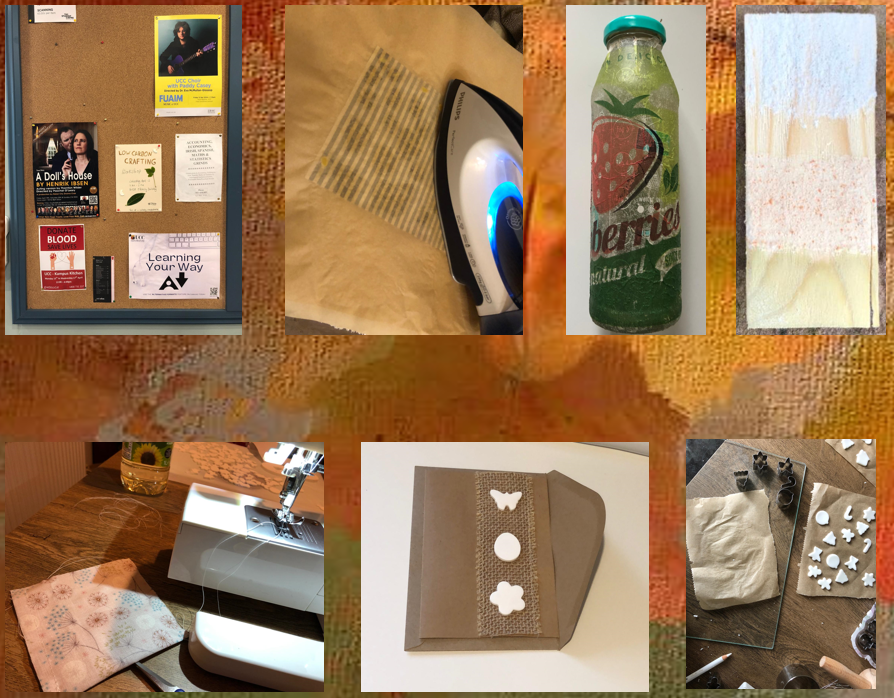
Recipes and Instructions
Different recipes and instructions for the workshop – from making glue and modelling clays from scratch to re using fabric leftovers to make useful items.
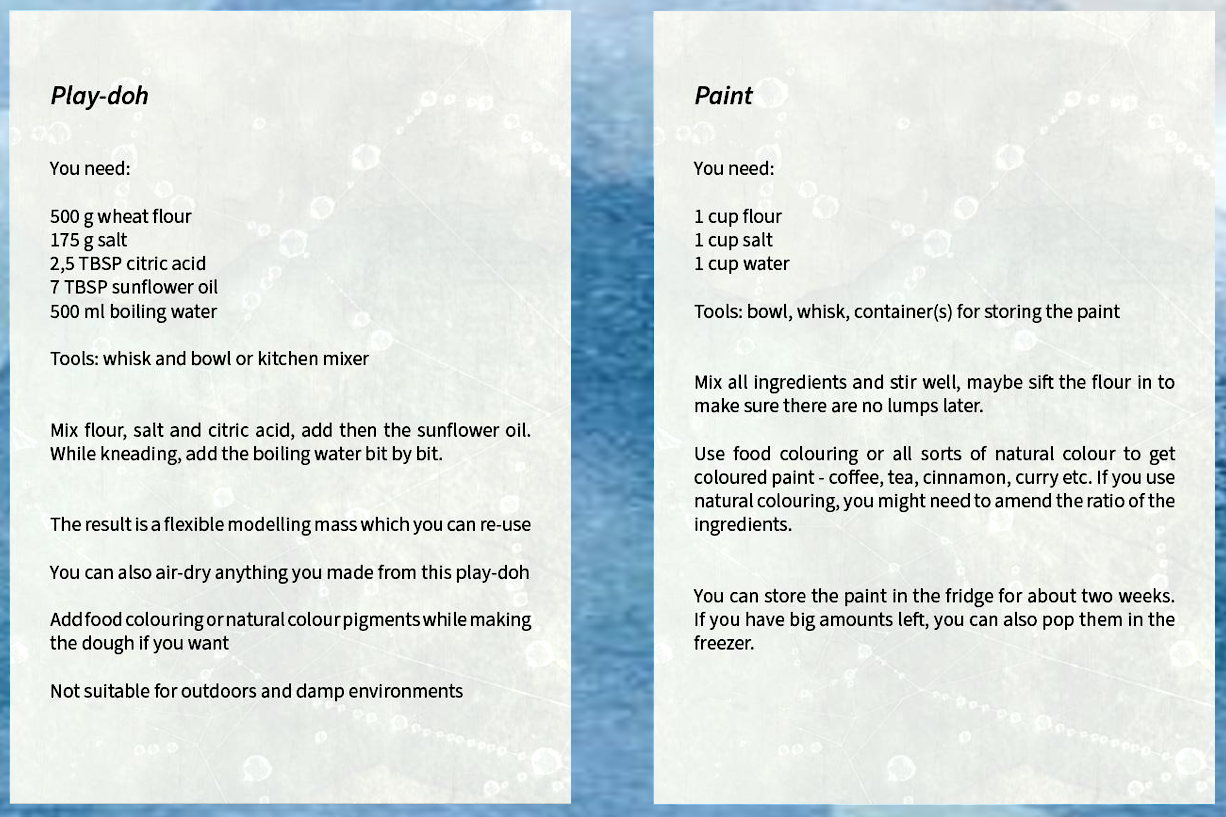
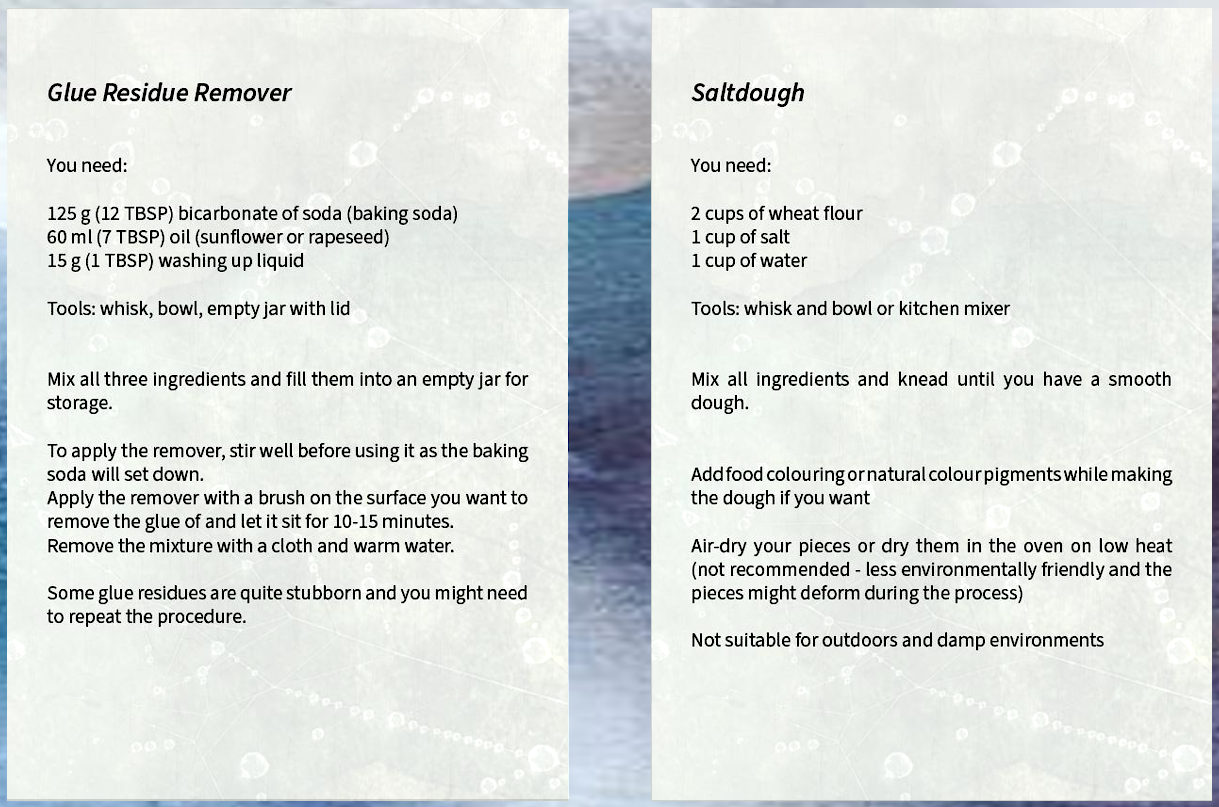
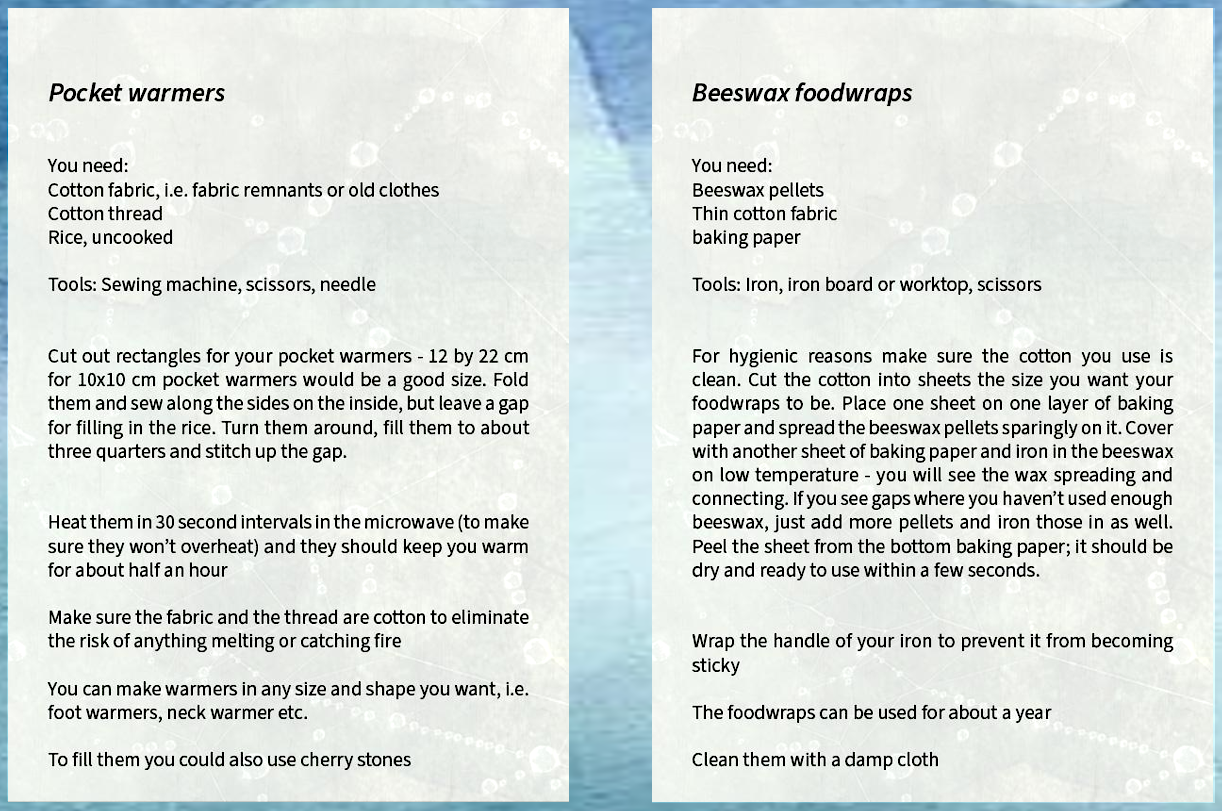
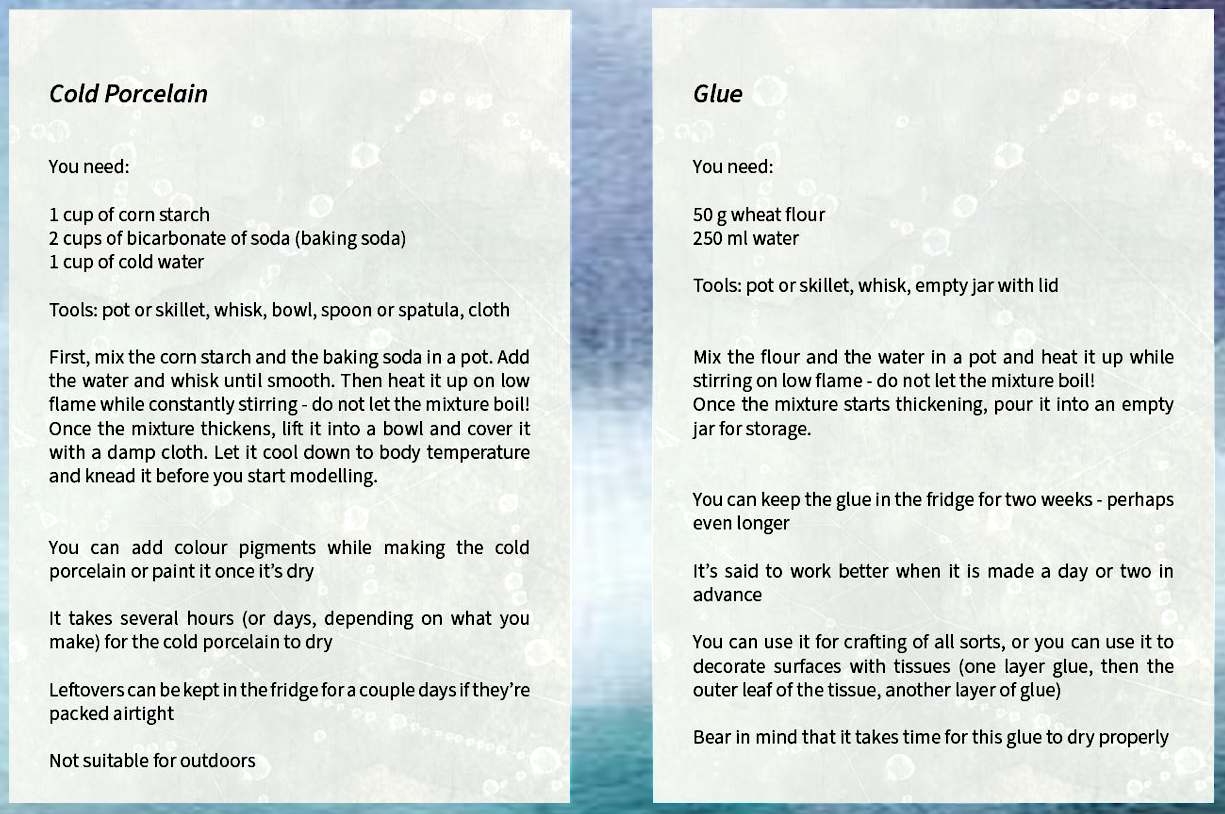
The Workshop
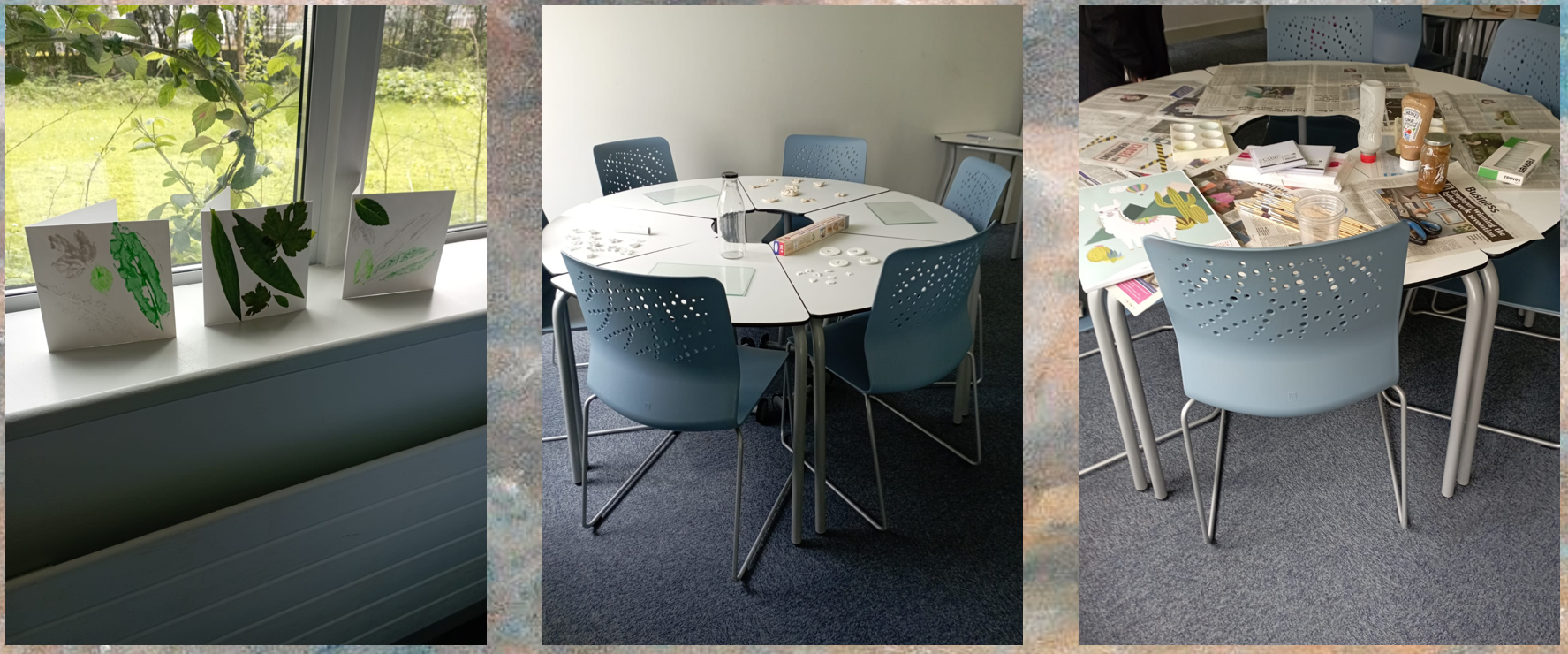
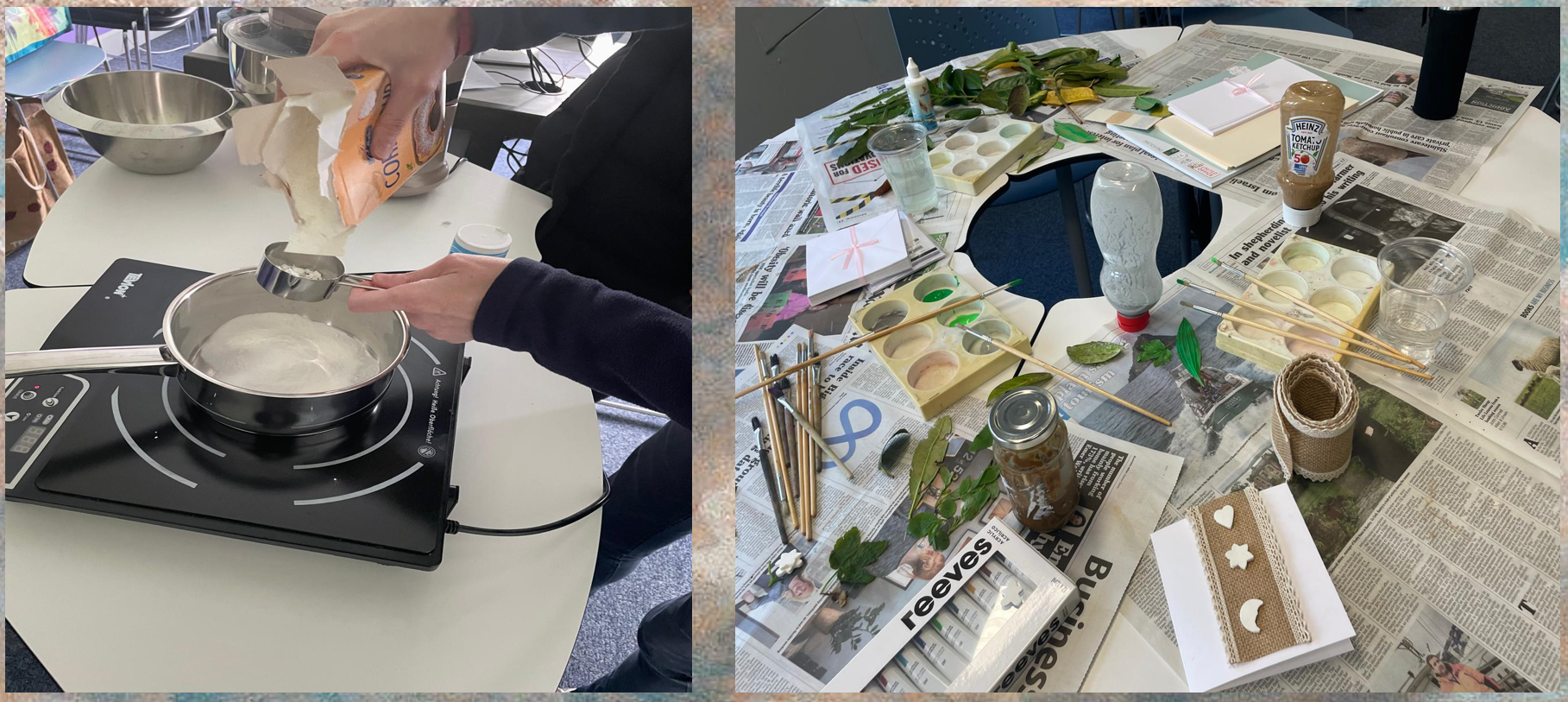
Action Plan – Post workshop evaluation
Participants enjoyed the activities we offered and the items they made
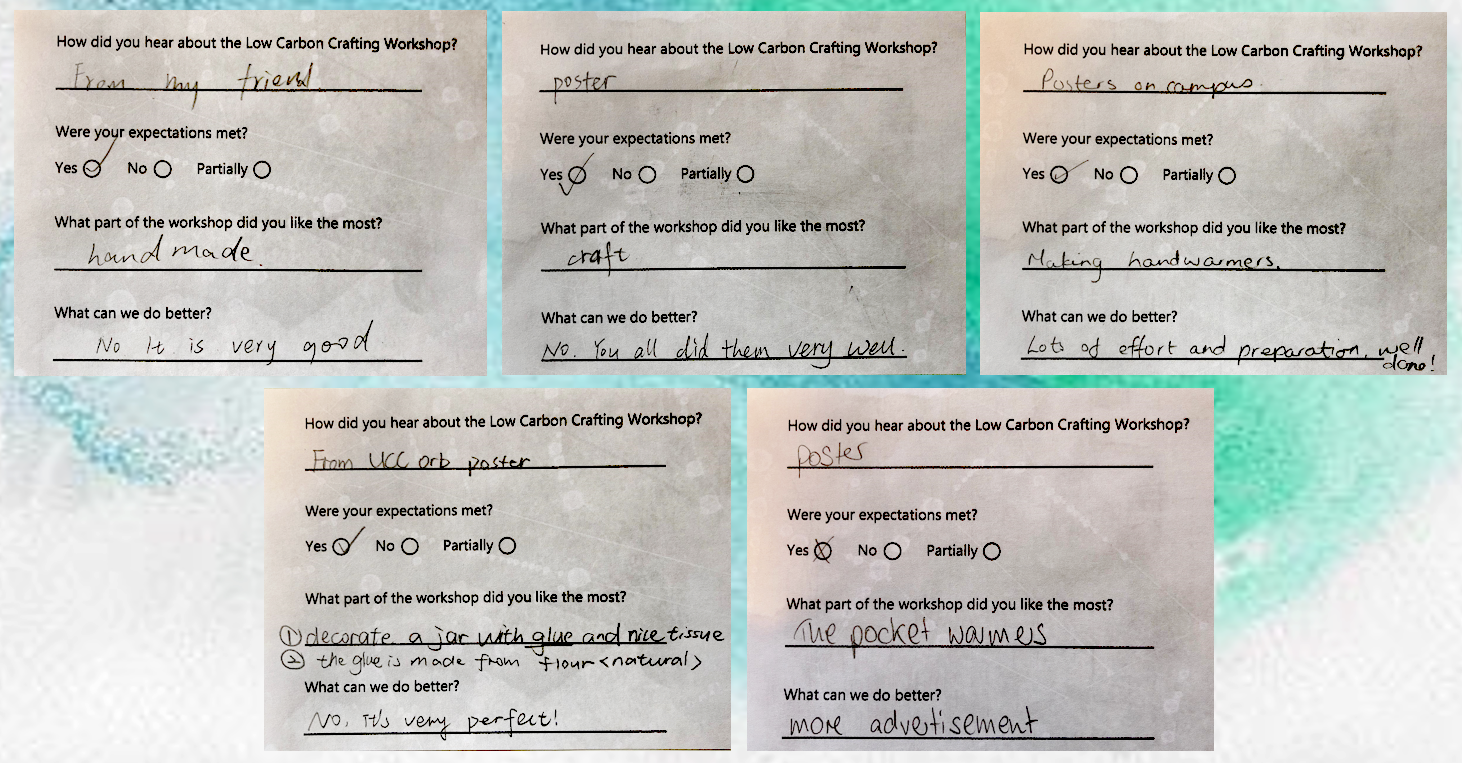
Theoretical Frameworks
Crafting workshops represent a unique opportunity to advocate for low-carbon practices within the framework of Global Citizenship and Development Education (GCDE). To effectively guide such a workshop, behaviour change, environmental psychology, and social dynamics are taken into account.
Activities in the workshop are designed to encourage participants at different stages of readiness for adopting low-carbon crafting practices. For instance, activities are structured to enhance participants’ awareness of the environmental impact of their crafting choices (precontemplation stage) and to provide them with practical skills and resources to make sustainable choices (preparation and action stages). By addressing attitudes, subjective norms, and perceived behavioural control, the workshop aims to facilitate meaningful shifts in participants’ crafting behaviours towards sustainability.
Environmental psychology offers additional perspectives on how the workshop environment can influence human behaviour. Concepts such as biophilia underscore the innate human connection to nature, which is leveraged to enhance participants’ engagement with low-carbon crafting practices. Natural elements incorporated into the workshop set and highlight the environmental benefits of certain crafting materials and techniques and participants are encouraged to develop a deeper appreciation for their role in environmental conservation. Furthermore, by creating a supportive and inspiring atmosphere, the workshop aims to foster positive emotional experiences that reinforces participants’ commitment to sustainable crafting practices.
Social learning theory emphasises the importance of social interactions and observational learning in shaping behaviour. In the workshop, participants have the opportunity to learn from each other’s experiences, skills, and perspectives on low-carbon crafting. Through collaborative activities and group discussions, participants not only share practical tips but also exchange motivations and aspirations related to sustainability. This social reinforcement serves to strengthen participants’ sense of community and collective responsibility towards reducing carbon emissions through crafting. The socialising aspect of the workshop is supported by the set up of different stations, where people can sit together and pursue their projects while they have conversations with each other.
The choice architecture presents eco-friendly and natural materials to the participants, nudging them to subtly influence their behaviour towards desirable outcomes. In the workshop, these concepts are applied through the design of the crafting environment and the framing of activities. For example, only eco-friendly materials are prominently displayed and readily accessible, making them the default choice for participants. Additionally, crafting activities are presented as opportunities to express creativity while also minimising environmental impact, thereby aligning participants’ intrinsic motivations with sustainability goals. Leaves picked up from the ground are utilised in the workshop and the room where the workshop is held is located on the ground floor and offers views into a green space, which helps creating a connection between participants and nature.
In conclusion, the integration of theoretical frameworks such as environmental psychology, social learning theory, and nudging offer valuable insights into understanding and fostering behaviour change in the context of a low-carbon crafting workshop. By applying these frameworks to workshop design and implementation, advocates like us can effectively promote sustainable behaviours and make meaningful contributions to the broader goals of Global Citizenship and Development Education.
Project
Process (Project Development)
The format for the workshop followed the design of Station Teaching. We had four stations; one station for card leaf printing and artwork design; one for moulding; one for glass jars with napkin papers/hand warmers and one for using the iron to make food wraps. Setting up the workshop to incorporate ‘stations’ would allow for participants to choose different stations according to their interests or they had the option to try materials at all the stations.
The creation of the survey was an interesting task. Attempting to invent compelling questions that would encourage students to question their own understanding of climate change and their carbon footprint was fascinating. Learning to link the survey responses with the presentation graphs for automatic updates and creating a response spreadsheet enabled me to create visual aids for our project from the survey. This was essential to the preparation for our presentation due to the insight it gave me for each person’s work. I also created and maintained the open PowerPoint used to work on the project together. This allowed me to enhance the PowerPoint’s visual display and cohesively combine all the group’s work.
At the beginning of this project, we were introduced to the Green Campus strict “no print” policy. This created a major obstacle to various aspects of the project. Posters were to be created to advertise the workshop to entice students to attend. These posters were to be distributed throughout the college, but such efforts could not be condoned by UCC Green Campus. This eventually led to us attempting to recreate our original poster as a biodegradable poster. While this was an acceptable alternative, the same was not achievable for the survey. Originally, another set of posters were to be spread throughout campus with a link to the survey. This would have allowed various students to participate with the survey. Instead, emails had to be utilised to spread the online survey through the student body, limiting its reach. Emails also contribute to an individual’s carbon footprint, as the storage of the emails sent results in larger emissions from companies as they store the data. This situation created a lose-lose argument between poster and emails, as both have an environmental impact. This was very interesting to learn, as without this project none of this would have occurred to our group.
Project Management
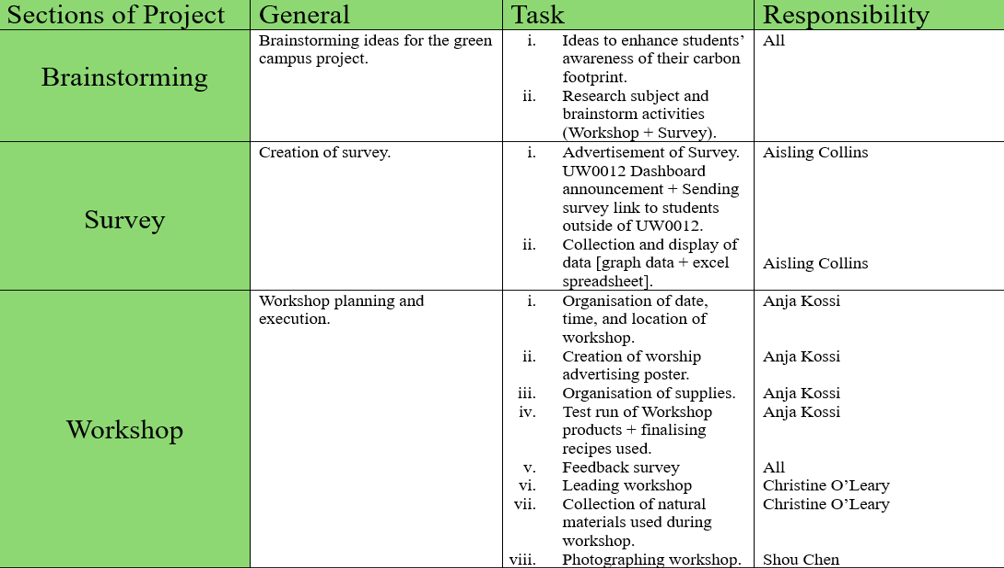
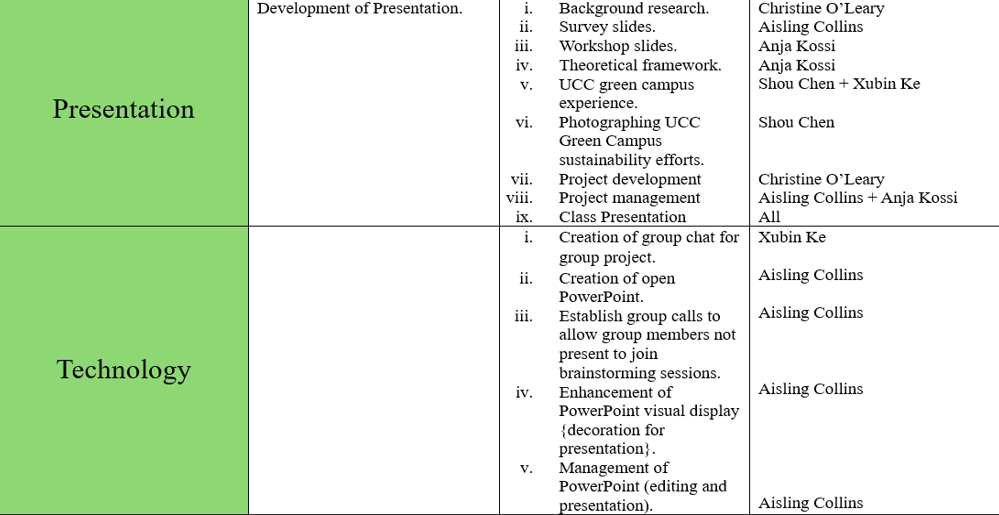
Green Campus at UCC
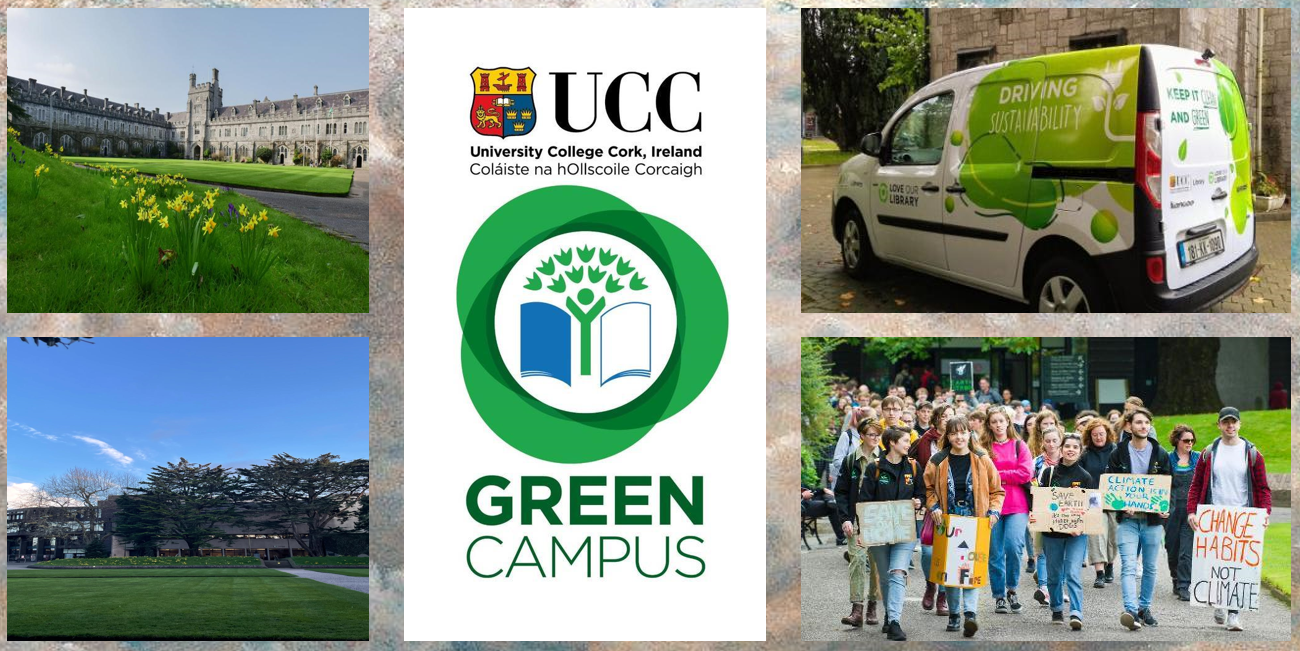
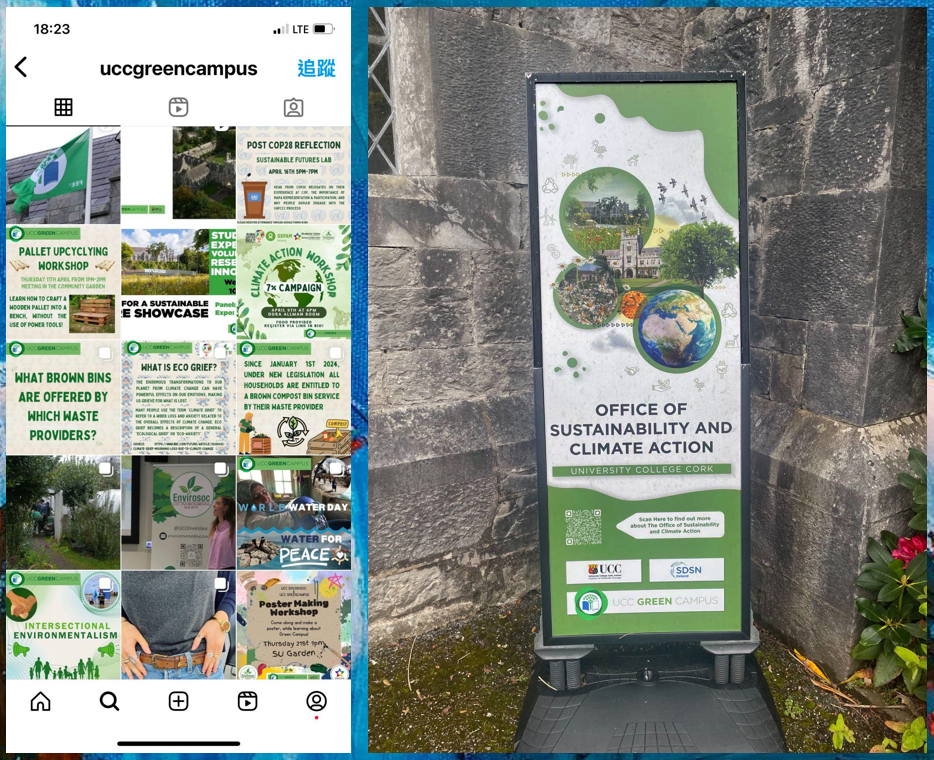
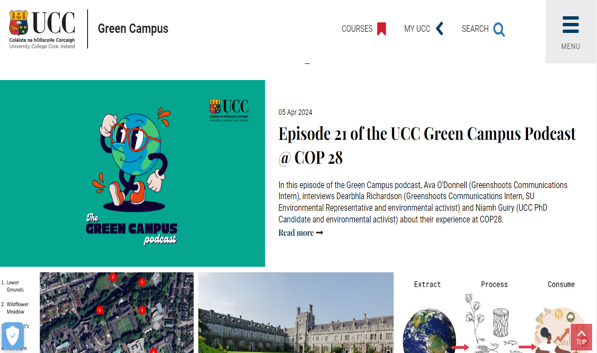
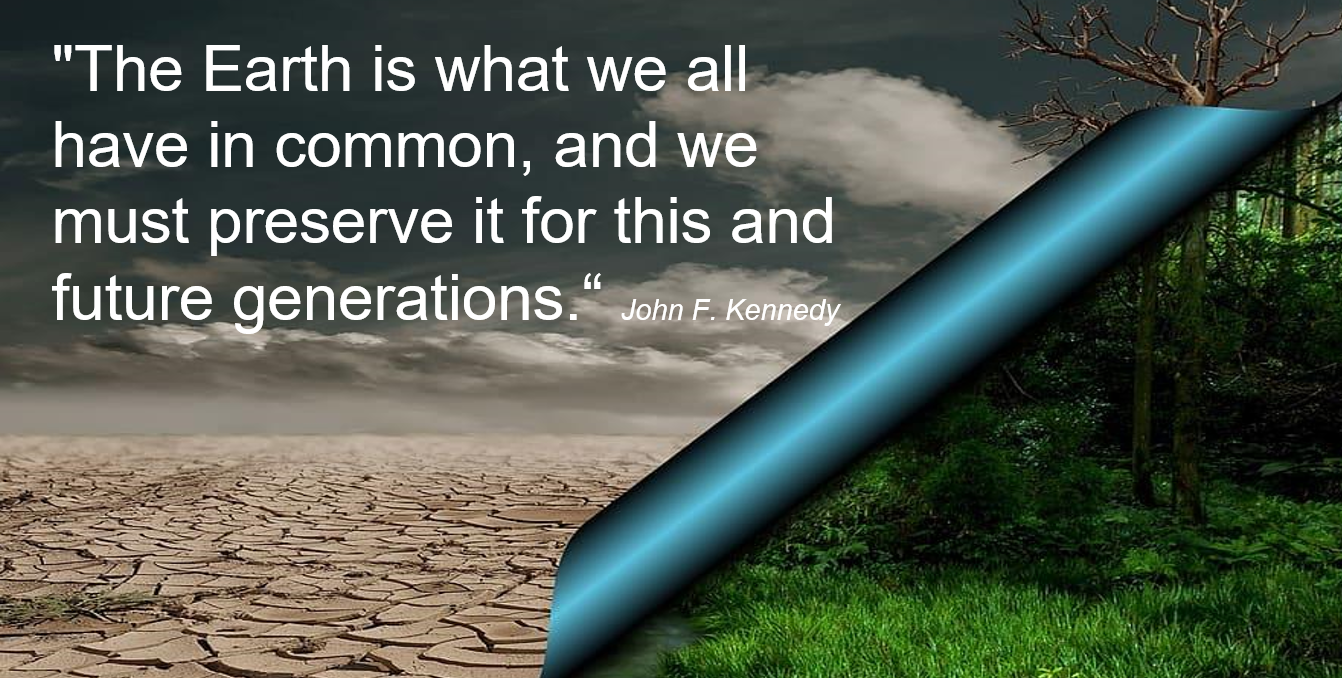
Individual Reflections
Aisling Collins
The survey investigates students understanding of the their carbon footprint while exploring how they think of their overall education on climate issues. I believe that this survey promoted an overall awareness on the efforts for sustainability.
The responses to this survey were fascinating. The difference in understanding in climate change and similar topics were completely varied depending on what course being studied (Ideas from a zoology student were completely different to the ideas presented by a student from an arts background).
I loved the impressive ideas presented on how to lessen your carbon footprint. It displayed the effectiveness of both the politically minded students and the artistic/DIY students. I think their combined approach would result in a far better impact on the lessening of our overall carbon footprint, alongside our own individual efforts.
Viewing a student’s understanding of climate change and the impact they can have on it, both positively and negatively, from outside the immersive knowledge I receive through my study of geography was very interesting. It allowed me to investigate general climate change education through a very different lens than I naturally possess.
The creation of this survey, its linked responses, the creation of the responses spreadsheet, and the open PowerPoint through Google Drive was an intriguing foray into the world of technology. This would not have been a role I would have previously been confident in, but this project allowed the expansion of my technological skills, especially as UCC Green Campus does not condone printing, in accordance with their ‘No-Print Policy’.
Anja
I would do some crafting at home every once in a while, and it was mainly only recently that I had found plenty of eco friendly ideas – the glue made from flour and water will probably be my all time favourite as it’s so strong and versatile, yet simple to make.
Organising and holding a workshop was something new for me and during the preparation process I learned a lot about how to do it right and how not.
I was most impressed by the simplicity of the items we made. There is only a small amount of specific things one would need to buy extra for the crafting, such as the beeswax pellets or fabric, in case there are no leftover pieces at home. Most of the ingredients would be already at home, like flour, starch, salt or rice and the making process is not complicated. The things we made would make a very nice gift and I am sure whoever receives a homemade item or piece of art will appreciate it, and even more when it is low in carbon.
The feedback was showing that our ideas were good, and I am happy to have seen participants fully enjoying every station at the workshop and being happy as soon as one item is completed. From one girl I learned, that in China cooked rice is being used to stick posters or decorations on walls!
Christine
Our workshop maintained the ethos of the Green Campus programme; to promote sustainability.
The materials that I used were sourced naturally; fallen leaves were collected for use in the print station, card and fabrics were from materials that were naturally derived and compostable.
Both participants and facilitators learned about sustainability through the workshop. As a facilitator, and as a teacher who teaches art lessons on a weekly basis, I can see the huge environmental benefits of using the homemade glue and paints that Anja tested, produced, and provided us with at the workshop. I will use these in my art lesson from now on, instead of the glue sticks that come with excess plastic packaging and paints that are heavy in chemicals.
Shou Chen
Our workshop was very interesting. Some good ideas and unique experiences touched me a lot. By participating in this activity and doing these interesting crafts, I felt the importance of a green campus and low-carbon life. Like rice cloth bags for hand warmers and reusable wax cloths, I feel that green campus life can start from these small things.
In general, the significance of a green campus is to protect the environment, promote sustainable development, improve the quality of the campus environment, save resource costs, and promote community participation and cooperation to lay a good foundation for future sustainable development. I gained a lot from this study.
Xubine Ke
Energy Consumption:
Energy consumption within campus buildings is another major source of carbon emissions. Heating, cooling, lighting, and powering electronic devices all contribute to carbon emissions. Implementing energy-efficient technologies such as LED lighting, smart thermostats, and energy-efficient appliances can help reduce energy consumption and carbon emissions.
TOP5 electrical consumers: western gateway, Boole library, Kane building&food science, BSI, and Main Rest. TOP5 Gas Consumers: Main Campus Gas, Brookfield Building, Western Gateway, Food Science Building, and O’Rahilly Building.
https://www.ucc.ie/en/greencampus/news/electrical-and-gas-consumption-semester-1-202122-.html
Food Services:
Food production, transportation, and disposal are significant contributors to carbon emissions associated with campus activities. By promoting sustainable food practices such as purchasing locally sourced and organic foods, reducing food waste, and offering plant-based menu options, universities can reduce the carbon footprint of their food services operations. Additionally, implementing composting programs can divert organic waste from landfills and reduce methane emissions.
Education and Awareness:
Education and awareness initiatives are essential for promoting sustainability and reducing carbon footprints on college campuses. By incorporating sustainability into curricula, hosting awareness campaigns, and engaging students, faculty, and staff in sustainability initiatives, universities can foster a culture of environmental responsibility. Empowering the campus community with knowledge and tools to reduce their carbon footprint can lead to meaningful and lasting change.
Authors
Aisling Collins; Anja; Christine; Shou Chen; Xubine Ke; Rio Yamamoto.
© 2024. All rights reserved. Praxis UCC.
